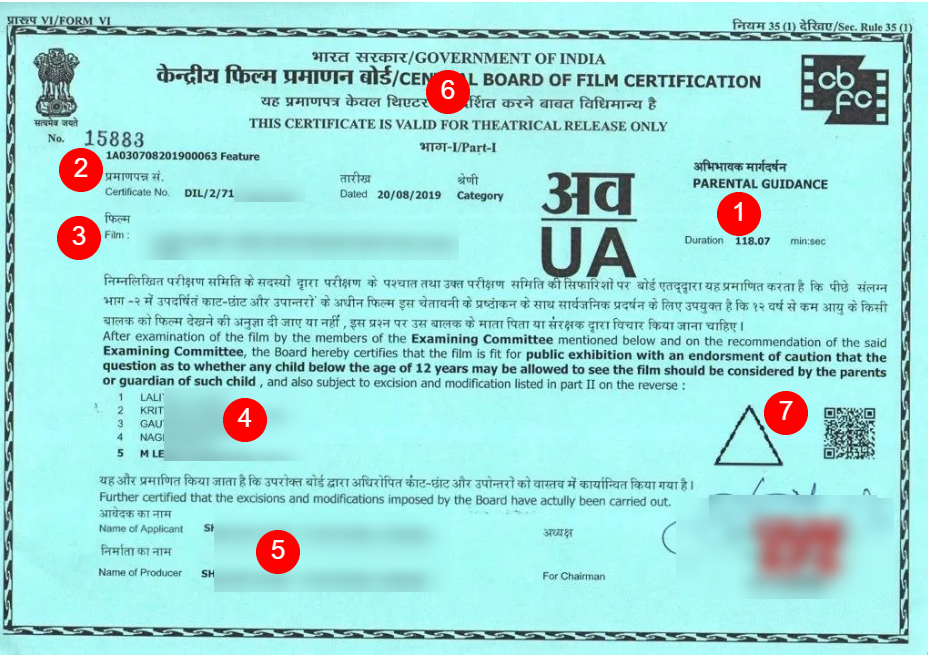Everything you should know about Indian Censor Board of film certification

- Country:
- India
From the last 16 years, the Censor board of film certification (CBFC) has banned 793 movies including movies like 'Parzania' and 'Mohalla Assi'. Some of them were banned for venereal scenes while some were banned for having controversial titles.
These include 586 Indian films and 207 foreign films, among these 231 Hindi films were refused a certificate, followed by 96 in Tamil, 53 in Telugu, 39 in Kannada, 23 in Malayalam and 17 in Punjabi.
The significant number of banned movies is a clear indication of why many filmmakers are switching to Over-The-Top (OTT) platforms which gives them more freedom over their content. OTT platforms deliver content to consumers via internet without the need for traditional cable, satellites or a movie theater. Apps like Netflix, Amazon Prime, Voot, and Hotstar are some of the popular OTT platforms.
But CBFC is also modernizing its working, it revealed a new logo with new changes in the film certificate. On August 31, 2019, CBFC hosted an event to unveil the new CBFC certificate. The certificate was introduced with a QR code to sync it with the digital world. The code is aimed at bringing more transparency and allowing the filmmakers as well as the audience to get more information about the film. The QR code can be scanned to know more details like date, duration and other information about the film.
The latest changes to the certificate seem useful and modern, but another pressing question is how does the censor board certify a film?
How is a film is certified by the Censor Board?
- The applicant has to apply to the regional office of the concerned region. Currently, there are nine regions of CBFC: Trivandrum, Chennai, Hyderabad, Bangalore, Mumbai, Cuttack, Kolkata, New Delhi, and Guwahati.
- On receipt of all film material and the fees, the regional office will form an examining committee to view the film.
- After the examination of the film, CBFC has to ensure that each member gives a report in writing about the modification required, if any, in the film which is further submitted to the chairperson.
- The Chairperson can again refer the film to a revising committee on his own or on the request of applicant. The appeal to the Revising committee can be done within 14 days. Once the Revising Committee examines the film and suggests the modification, the applicant has to make the changes.
- If the applicant is rigid to his decision of not making changes then he or she can appeal to Film Certification Appellate Tribunal headed by a retired judge.
According to rule 41 of Cinematograph rules, it takes a total time limit of 68 days for the certification process and within this duration, the intellectual owner or the producer is not allowed to call or have any other kind of communication (except for emails) with the members of the committee or any CBFC officer.
Everything to know about Film Certificate:
There are 4 types of certificates provided by CBFC to films.
(U Certified): This Is the 'Universal' movies that anyone can watch. These kinds of movies sometimes also have social messages or may have mild violence or intimate scenes but those are overseen.
(U/A Certified): This certificate suggests that parental guidance is required for children below the age of 12. These movies may contain some moderate intimate or violent scenes.
(A Certified): Restricted to adults, only people above the age of 18 can watch these films because of the strong intimate or violent content.
(S Certified): Restricted to a special class or person, films with S certificate can only be viewed by special classes such as Doctors, Engineers, Scientists, etc. These movies are not exhibited to the public and CBFC had stated that the exhibition of these films to people for whom it isn't meant to be is a violation of the Indian Cinematograph Act of 1952.
The film certificate consists of major 7 details other the certification of the film, they are as follows:

- Next to the certification on the right side, you will find the duration or length of the film.
- On the extreme left, below the national emblem, you will find the film's certificate number, the year of certification and location of the Censor Board office.
- Right below it, the name of the film is written in block letters followed by the language, color, and type of the film either it is 2D, 3D, etc.
- Below the name of the film, there are names of the censor examine committee that has examined the film.
- In the bottom-left, there are the names of the applicant and the producer.
- In the top-center, the validity of the film certificate is mentioned.
- There is a triangle shape mark present in the right-hand center which denotes that cuts were suggested to the movie. If the triangle is not present in the certificate that means no cuts are suggested to the movie and the movie has been passed by the Censor with a clean chit without any cuts and modifications.
ALSO READ
Iconic James Bond Films Are Set to Stream on Netflix in 2026
Warner Bros Discovery at Crossroads: Paramount's Takeover vs. Netflix's Bid
Warner Bros. Rejects Paramount's Hostile Takeover Bid; Netflix Deal in Spotlight
Entertainment World Shaken: Netflix's FIFA Game, Murder Charges Against Reiner's Son, and Warner Bros' Rejection of Paramount
Battle for Warner Bros: Paramount vs. Netflix in the Streaming Wars










